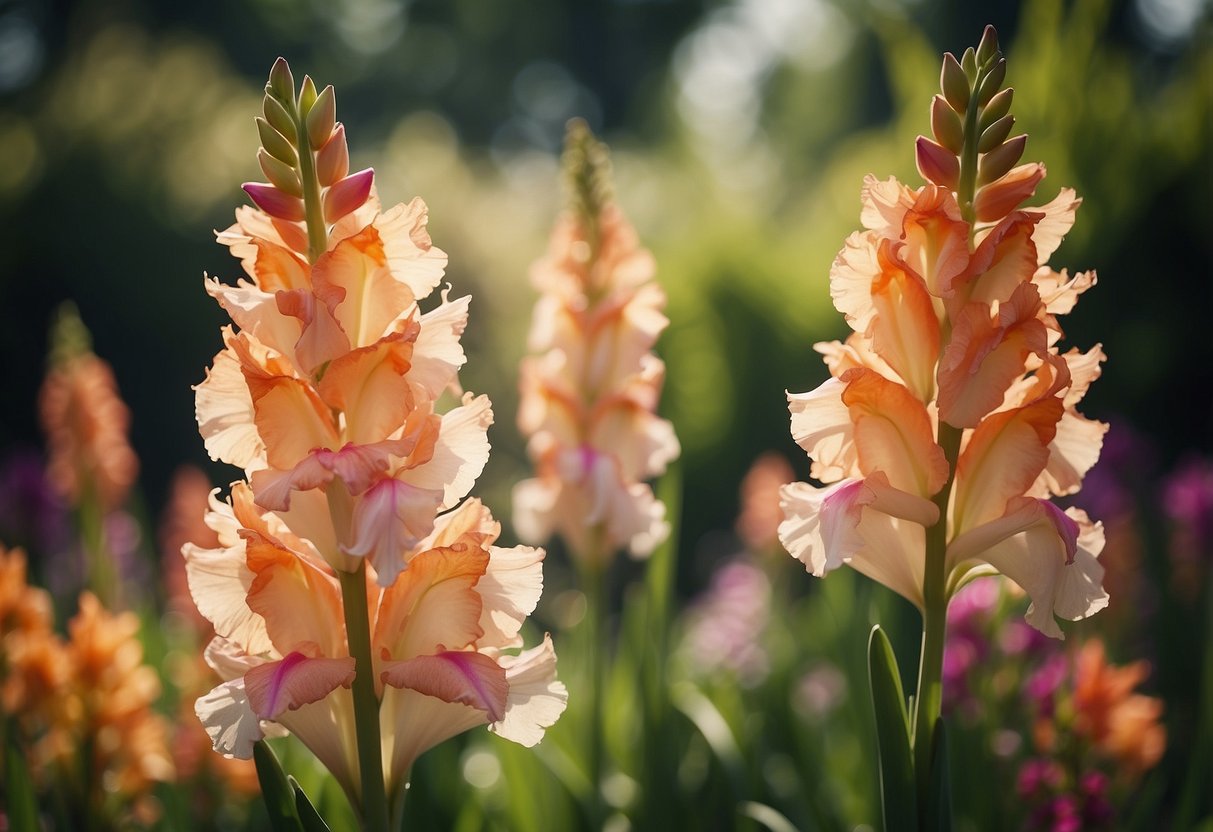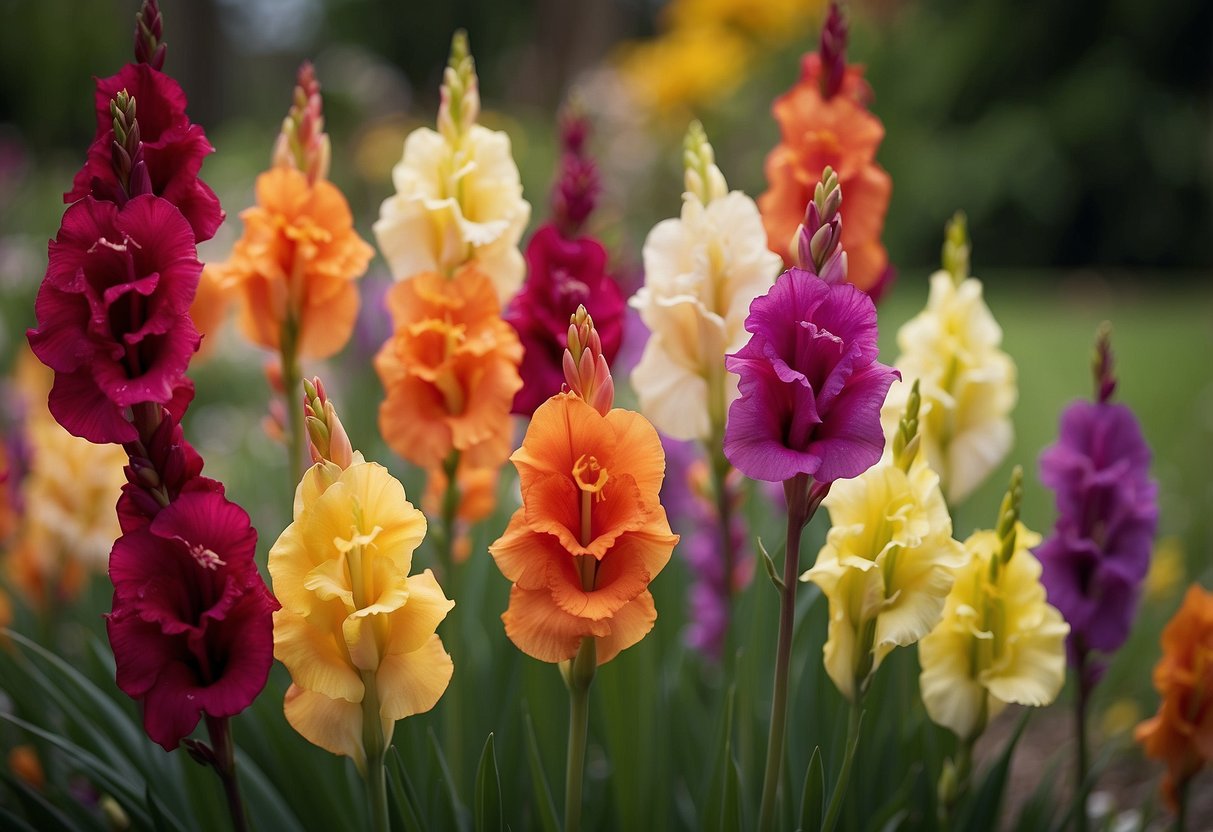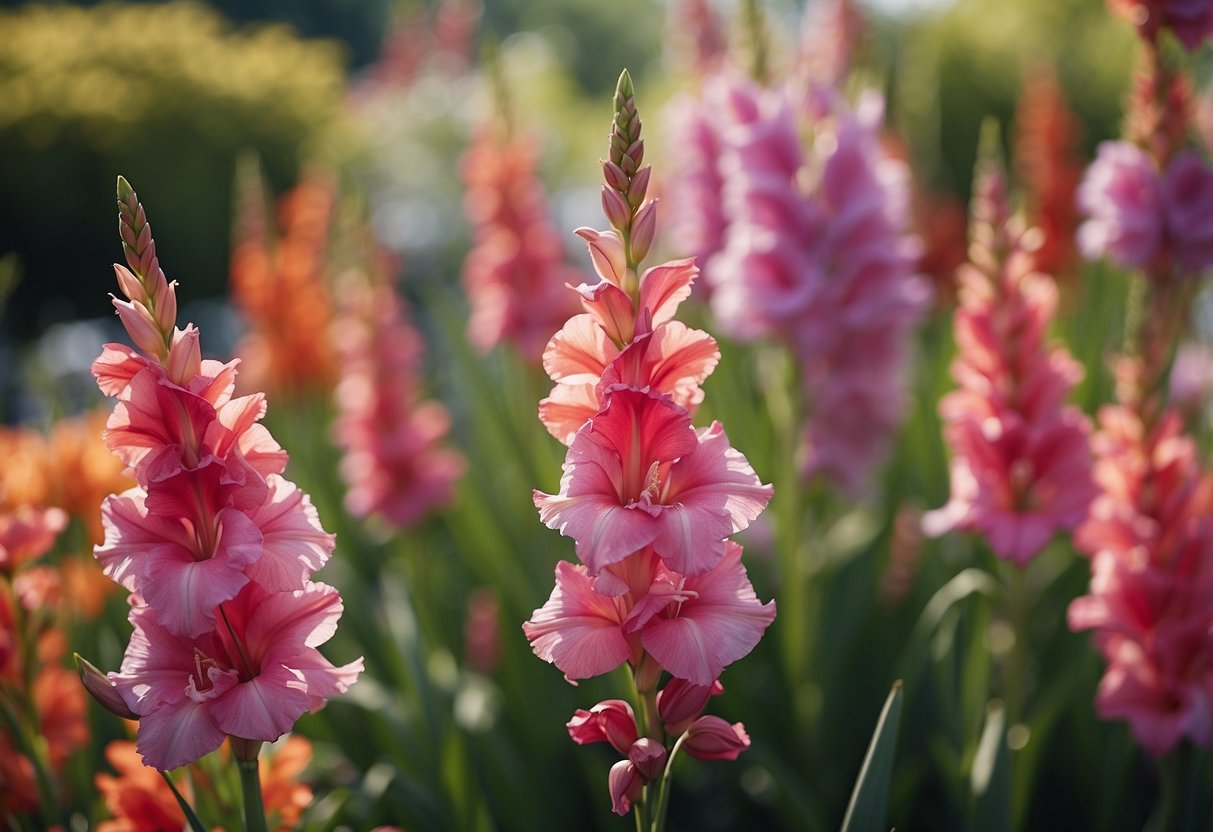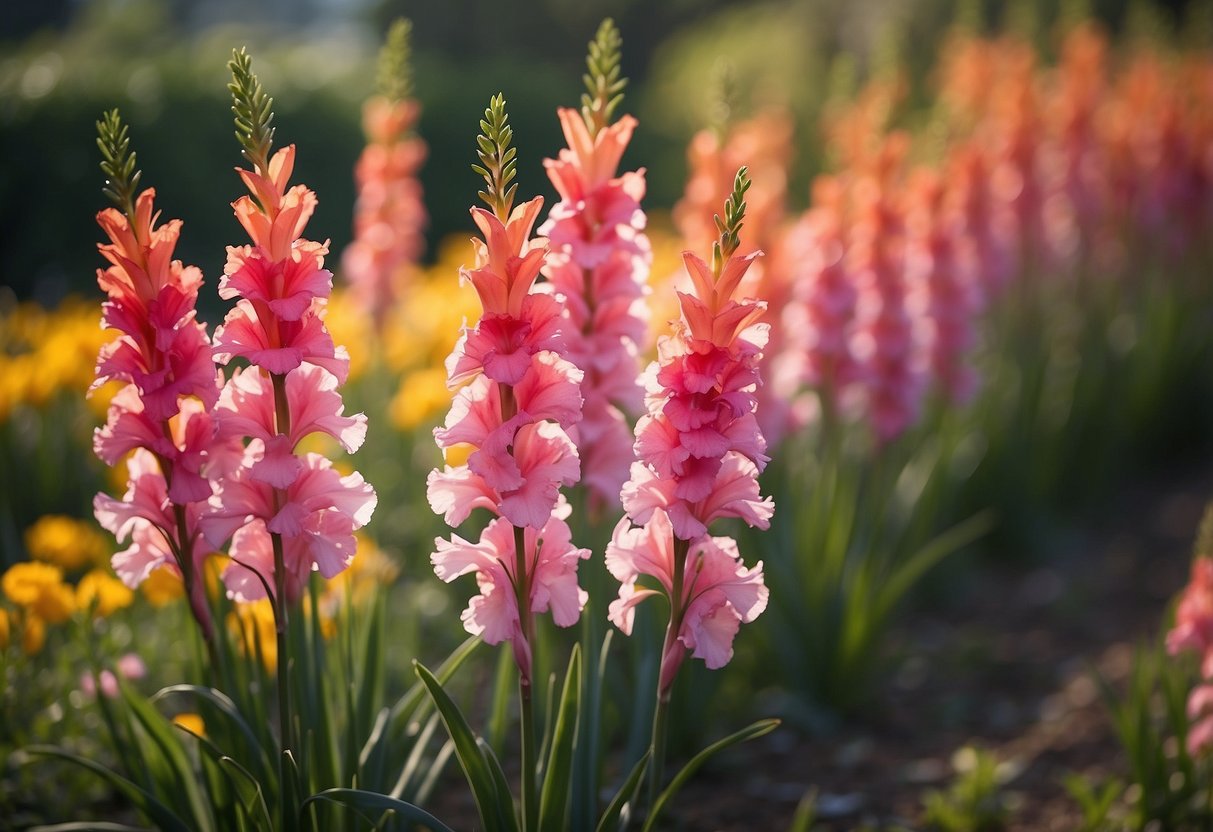Gladiolus Garden Ideas: Vibrant Blooms for Your Backyard
Do you dream of adding vibrant color and elegant charm to your garden? Look no further than gladiolus flowers. Whether you’re an experienced gardener or just starting out, these stunning blooms will make a remarkable addition to your outdoor space.

Why choose gladiolus for your garden? These flowers are known for their tall, striking spikes of flowers that come in a wide variety of colors. They not only create a beautiful landscape but also add vertical interest, making your garden look more dynamic and lively. Explore the endless possibilities of incorporating gladiolus into your garden designs and get ready to be inspired.
1) Create a Rainbow Bed

To make a rainbow bed with gladiolus, choose flowers in a variety of colors. Gladiolus come in many shades, including red, pink, yellow, and purple.
Plant them in groups based on color, creating bands that look like a rainbow. This gives your garden a vibrant, layered effect.
Water regularly to keep the blooms healthy. Gladiolus need about an inch of water per week.
2) Edging with Gladiolus

Gladiolus can add a vibrant edge to your garden. They grow tall and have beautiful, colorful blooms.
Plant them in well-drained, sandy soil. They need plenty of sunlight to thrive.
Use gladiolus for a bright and lively garden border. Mix them with other flowers like zinnias and dahlias for variety.
3) Container Gardening

You can grow gladiolus in pots if you have limited garden space. Use a container at least 12 inches deep for proper root growth. Choose a well-draining soil mix to prevent waterlogging.
Place the bulbs 3-4 inches apart and cover with 4 inches of soil. Keep the pots in a sunny spot and water consistently. Container gardening allows you to move your gladiolus to highlight their blooms.
4) Cut Flower Arrangements

You can create beautiful cut flower arrangements with gladiolus. Choose healthy stems that have a lot of closed buds. This ensures your flowers will last longer.
Use a sharp knife to cut the stems at a 45° angle. This lets the stems take in more water. Change the water every two days to keep the flowers fresh.
Remove any leaves that fall below the water line to prevent rot. For best results, place the vase in a cool spot, out of direct sunlight. Enjoy your stunning gladiolus display!
5) Accent Garden Pathways

Gladiolus can add vibrant colors to your garden paths. Plant them along the edges to create a striking border. Their tall, sword-like leaves and bright flowers will guide visitors and enhance the overall look.
Another idea is to mix gladiolus with other flowers like zinnias or dahlias. This combination provides constant blooms and variety along your walkway. Ensure the soil is well-drained and receives plenty of sunlight for the best results in this radiant setup.
6) Vertical Gladiolus Walls

Using gladiolus plants to create vertical walls is an exciting way to add height and color to your garden.
Plant gladiolus bulbs in tall containers or vertical garden systems. These flowers grow tall and can fill empty vertical spaces with their bright blooms.
Combine gladiolus with climbing plants or vines for a layered look. This will bring even more texture and interest to your garden.
7) Mix Colors and Textures

You can make your gladiolus garden more exciting by mixing different colors. Think about combining bold reds and yellows with softer pinks and purples.
Add texture by planting gladiolus with other flowers like Bearded Iris, which has intricate “beard” details. This creates a rich and varied display that’s pleasing to the eye.
Don’t forget to use different heights and shapes to add depth. For instance, plant taller varieties like Gladiolus ‘Night Rider’ in the back and shorter ones in the front. This adds a layered, lush look to your garden.
8) Pair with Perennials

Pairing gladiolus with perennials can create a striking garden display. Plants like bearded iris and daylilies thrive in similar conditions and add beauty with their blooms.
Consider planting gladiolus with asters and coneflowers for height and color contrast. This mix will keep your garden vibrant through different seasons.
Lavender and coreopsis are also great choices. They attract pollinators and provide a lovely backdrop for your gladiolus.
9) Use in Rock Gardens

Gladiolus can add a striking touch to rock gardens. Their tall, vibrant flowers stand out beautifully against the texture of rocks.
Choose varieties that complement your other rock garden plants, like perennials and ornamental grasses.
Make sure to plant them in well-drained, sandy soil to keep them healthy and thriving. See more rock garden ideas here.
10) Gladiolus Fencing

You can make your gladiolus garden more interesting by planting gladiolus along a fence. This adds a touch of color and provides support for tall blooms.
A picket fence works beautifully. You can plant gladiolus corms close together along the base. Use organic soil and bulb fertilizer to make your flowers thrive.
Gladiolus planted against a fence helps prevent them from falling over. The fence acts as a natural support, keeping the flowers upright and neat.
Planning Your Gladiolus Garden

When planning your gladiolus garden, consider location, soil quality, and the types of varieties you want to plant. This way, you’ll enjoy vibrant blooms and healthy plants all season long.
Choosing the Right Location
Gladiolus thrive in sunny spots. Aim for at least 6 to 8 hours of direct sunlight per day. Too much shade leads to spindly growth and fewer blooms.
Look for an area protected from strong winds. Gladiolus have tall flower stalks that can easily get damaged. Consider planting near a fence or using stakes for support.
Soil Preparation
Good soil is key to successful gladiolus growth. They prefer well-draining soil rich in organic matter. If your garden has clay or sandy soil, improve it by adding compost or manure.
Loosen the soil to a depth of at least 12 to 15 inches. This helps roots grow deeper and stronger. Spread a 2-inch layer of mulch on the surface to retain moisture and suppress weeds.
Selecting Gladiolus Varieties
There are numerous gladiolus varieties to choose from. Select based on bloom time, color, and size. For continuous blooms, plant corms every two weeks from early spring to midsummer.
Some popular varieties include:
- Gladiolus Priscilla: Soft white petals with pink edges.
- Gladiolus Blue Moon: Striking blue flowers.
- Gladiolus Friendship: Bright yellow blooms.
Mix varieties to enjoy a range of colors and shapes. Stagger planting times to extend the flowering season.
By choosing the right location, preparing the soil well, and selecting diverse varieties, your gladiolus garden will be a beautiful addition to your landscape.
Planting Gladiolus Bulbs

Planting gladiolus bulbs is straightforward if you follow key guidelines on timing, depth, spacing, and watering. Proper care will ensure your garden bursts with these vibrant flowers.
When to Plant
For the best blooms, plant gladiolus bulbs in the spring after the last frost. This usually means mid to late spring, depending on your climate.
Stagger planting every two weeks until early summer to enjoy continuous blooms throughout the season. Gladiolus take around 70-90 days from planting to blooming, so this staggered approach ensures a steady display of flowers.
Planting Depth and Spacing
Plant your bulbs 4-6 inches deep. This depth helps support their tall flower spikes.
Space each bulb 6-8 inches apart. Plant them in groups or drifts of at least seven bulbs for a more impactful display.
Ensure the soil is well-draining and amended with compost for added nutrients. This improves soil structure and helps your plants thrive.
Watering Guidelines
Water the newly planted bulbs well to help them establish. Keep the soil consistently moist, but not waterlogged.
Once the gladiolus start growing, water them deeply once a week. In very hot or dry conditions, you might need to water more frequently.
Adding mulch around the plants helps retain moisture and keeps the soil cool, promoting healthy growth.
Caring for Your Gladiolus

Taking care of your gladiolus involves proper fertilization, managing pests and diseases, and supporting the growing stems. These key practices will ensure healthy plants with vibrant blooms.
Fertilization Tips
To encourage healthy growth, apply a general-purpose or phosphorus-rich fertilizer in late winter to early spring. Feed the plants when you first see green shoots emerging from the soil.
Avoid over-fertilizing, as this can result in lush foliage but fewer flowers. A balanced approach works best.
You can use a liquid fertilizer every two to three weeks during the blooming season.
If your soil lacks nutrients, consider adding compost or well-rotted manure. This helps retain moisture and improves drainage.
Pest and Disease Control
Gladiolus are susceptible to pests like thrips, aphids, and spider mites. To manage these insects, consider using insecticidal soap or neem oil. Regularly inspecting your plants can help you spot problems early.
For fungal diseases, ensure good air circulation around your plants. Avoid overhead watering as wet leaves can lead to diseases like botrytis blight.
Dispose of any infected plant material to prevent the spread of disease.
Staking and Supporting Stems
Gladiolus stems can be tall and may require staking to keep them upright. Use bamboo stakes or other supports to keep them from bending or breaking.
Tie the stems to the stakes loosely with soft garden twine or fabric strips. This prevents damage while providing necessary support.
Check the plants regularly to adjust the ties as the stems grow taller. This helps keep them straight and prevents them from falling over.
Harvesting and Enjoying Blooms

To get the best from your gladiolus flowers, it’s essential to know when and how to harvest them. You’ll also want to learn tips for arranging and extending their vase life.
When to Cut Gladiolus Flowers
Cut gladiolus flowers early in the morning or late in the evening. These times are best as the temperatures are cooler, which helps the flowers last longer. Look for the florets at the bottom of the spike to start opening. This is the right time to cut the stems because the upper florets will still bloom after being placed in water.
Use a clean, sharp knife or garden shears. Cut the stem at an angle. Leave a few of the lower leaves on the plant to ensure it continues to photosynthesize. This helps the corm store energy for next year’s growth.
Arranging Gladiolus in Bouquets
Gladiolus are the perfect choice for tall and eye-catching arrangements. Since they have long stems, use a tall vase. Make sure the vase is clean. Remove any leaves that would be submerged in water, as they can cause bacteria growth.
Combine gladiolus with other flowers that have similar water needs. Flowers like zinnias and dahlias work well. If you are aiming for a mixed bouquet, include shorter flowers and greenery for contrast. This balance creates a fuller, more visually appealing arrangement.
Extending Vase Life
To enjoy your gladiolus blooms for as long as possible, change the water in the vase every two days. Add flower food to the water or mix a homemade solution of sugar and vinegar. These keep bacteria at bay and provide nourishment.
Trim the stems every few days. Cut about half an inch off to keep the water flow strong. Keep the vase in a cool spot, away from direct sunlight or heat sources, to prevent wilting. Removing any wilted or spent flowers will also help the remaining florets to bloom better.
By following these tips, your gladiolus arrangements will stay fresh and vibrant for as long as possible, bringing a burst of color into your home.







